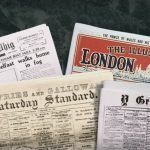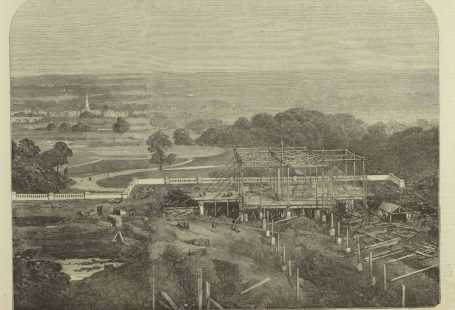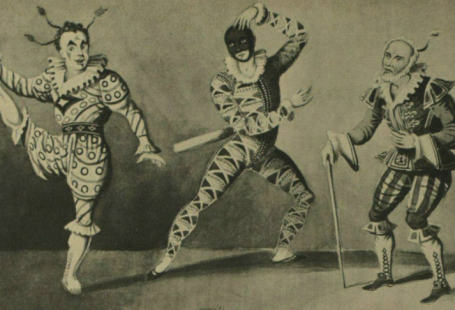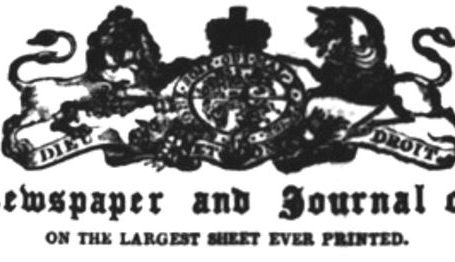This week at The Archive we have been immensely busy adding 397,534 brand new pages to our newspaper collection, with the addition of four brand new titles from Kent, Suffolk and Manchester. Meanwhile, we’ve been busy updating our existing titles from across England, Scotland, Northern Ireland and the Republic of Ireland.
So read on to discover more about all of our new and updated titles of the week, and also to find out about the burning of Parliament in October 1834, where London witnessed its biggest fire since 1666.
Register now and explore the Archive
We begin our exploration of The Archive’s new titles of the week in Suffolk, namely in Bury St Edmunds, the historic market and cathedral town. And we’re delighted to introduce venerable Bury St Edmunds title the Bury and Suffolk Herald, which was first published on 28 March 1827 in the market town as the Suffolk Herald. The successor to the Bury Gazette, the Suffolk Herald was printed and published by T.D. Dutton, appearing every Wednesday at the price of seven pence.

The new Suffolk title was resolutely Conservative. Indeed, the first edition of the newspaper stated its position as a ‘friend of true Constitutional Principles,’ describing how:
Whilst professing REAL independent principles, the Proprietors of The SUFFOLK HERALD think it necessary to state, that, aware as they are of the necessity of preserving the ancient land-marks of our free Government, they will resist, to the utmost, every species of innovation upon its venerable fabric. Duly appreciating the blessings of our Protestation Constitution, The SUFFOLK HERALD will send its warning voice against the admission of Catholics to political power…
Meanwhile, the first edition of the Bury and Suffolk Herald stated its support of agriculture, an important local industry:
The pursuit of Agriculture is one of the greatest importance. It is the capital, skill, industry, and enterprise of the British Farmer which supports our large and increasing population; and, bearing in mind the burthens with which he has to contend, The SUFFOLK HERALD will endeavour to prove, by arguments unanswerable, not only the justice and expediency, but the great national policy, of ensuring to the cultivators of our soil a fair remuneration (and they desire nothing further) for their capital, skill, and labour.

So what did the pages of the Bury and Suffolk Herald contain? The newspaper presented robust coverage of local legal proceedings, with sections devoted to the Suffolk, Essex and Norfolk Assizes, as well as general ‘Assize Intelligence.’ The Bury and Suffolk Herald looked further afield too, to report on news from London and from parliament, as well as from the country’s universities, Oxford and Cambridge. Finally, the newspaper also contained notices of births, marriages and deaths, original poetry, correspondence, and market intelligence.
Staying in Suffolk now, and indeed within Bury St Edmunds, and we’re excited to welcome the Bury & Suffolk Standard to our collection. First published on 9 March 1869 and appearing every Tuesday, the Bury & Suffolk Standard followed in the political footsteps of the Bury and Suffolk Herald, being resolutely Conservative in its politics.

Indeed, the Bury & Suffolk Standard professed itself to be, in its first edition, a ‘Conservative organ,’ relating how:
We profess to uphold the principles of the Constitution, as safeguards to the dignity of the Crown and the liberties of the subject; and in so doing we shall claim the good will of all of who prize the institutions under which England has reached a point of national and private prosperity hitherto unknown; our energies will be employed in maintaining unimpaired that fabric which a school of pseudo-philosophers ranking amongst its disciples the thoughtless and disaffected would disparage and destroy.
Indeed, by 1888 the Bury & Suffolk Standard was seeing great success, an advertisement for the paper describing how the newspaper was:
…the only Conservative and the only Penny Paper in the District, [having] a larger circulation throughout the greater part of West Suffolk, and the borders of the Norfolk and Cambridgeshire than any other; and in a considerable part of the district it is guaranteed to have a more extensive circulation than ANY OTHER TWO PAPERS COMBINED.
It boasted of being read by ‘all classes,’ containing a ‘carefully-prepared epitome of the news of the week,’ as well as being ‘the organ of the Church of England and Conservative party in West Suffolk.’
For all its posturing, the eight page Bury & Suffolk Standard was a robust and thorough local newspaper, offering the latest ‘local intelligence’ from the likes of Mildenhall, Lowestoft, Cowlinge, Herringswell, Ely, Norwich, Stowmarket, Cavendish, Diss, and, of course, Bury St Edmunds. It reported on news from the local petty sessions, the Bury Town council, and published the local railway timetable.

The newspaper looked further afield too, offering ‘Foreign Intelligence’ from America, Prussia, Turkey, Greece, and Australia, as well as containing news from closer to home, from parliament, from the army and navy, from the church and the universities, from the court and from the London police. Meanwhile, the Bury & Suffolk Standard contained several special interest features, looking at the gardening tasks for the week and ‘sporting intelligence.’
Furthermore, the Bury & Suffolk Standard had an especial focus on agriculture, looking at the news from the Central Chamber of Agriculture, and looking at the Minister of Agriculture as well. With agriculture being integral to the local Suffolk economy this is no surprise, and the Bury & Suffolk Standard was keen to represent local interests.
We move slightly further south now to Kent for our next new title of the week, which is the Northfleet and Swanscombe Standard. This newspaper was first published in Gravesend on 15 August 1896, covering the town of Northfleet and the village of Swanscombe, which lies to the west of Gravesend.
The first edition of the newspaper laid out its intentions:
We are to-day launching a new venture on the Northfleet and Swanscombe public, in whose hands the success of the Northfleet and Swanscombe Standard will lie. It is not altogether our own idea to publish a first-class halfpenny weekly newspaper in these thrifty towns, but we are acting upon the suggestion of a large number of the inhabitants of Northfleet, whose cry for some time has been ‘give us a paper of our own.’
Indeed, the unique selling point of the new newspaper appeared to be its price, as the proprietors claimed that they would sell ‘the only half-penny paper in Northfleet and Swanscombe.’ And although the newspaper was low in price, it did not lack for content, filling as it did eight pages.

The Northfleet and Swanscombe Standard devoted its pages to local issues, reporting the latest from the Northfleet Police Court, the Northfleet School Board, the Gravesend Town Council, the Gravesend Police Court, and the Tilbury School Board. It furthermore looked at local issues through its ‘Gravesend Paragraphs,’ whilst also reporting on local sport, covering cricket, cycling, the Kent County Football Association and the Gravesend Cricket Club.
Meanwhile, the newspaper featured a look at cultural items, such as the ‘London Theatre and Music Halls,’ as well as containing serailised fiction, with stories like the Jean Middlemass tale Maisy’s Triumph filling its pages. Finally, the Norfleet and Swanscombe Standard contained notices of births, marriages and deaths, a look at ‘Timely Topics,’ as well as ‘Hints to Married Men.’
Our final new title of the week is the Manchester Metro News, which was a weekly freesheet that was founded in 1992 as the Manchester Metro News Trafford. Delivered to homes in the Metropolitan Borough of Trafford, in Manchester’s south west, this newspaper took in the towns of Stretford and Urmston, as well as Sale, Altrincham, Timperley, Bowdon, Partington and Hale.
Appearing every Friday, in 2008 the newspaper became known as the Trafford Metro. The final editions of the Manchester Metro News appeared in 2010.

That’s it from our fantastic four new titles of the week, but we have a bumper crop of existing titles that have been updated this week. Leading the charge is the Derby Daily Telegraph, to which we have added a staggering 245,491 brand new pages, which take in nearly one hundred years from 1888 through to 1985. Following behind the Derby Daily Telegraph is the Staffordshire Sentinel, to which we have added over 42,000 new pages, which span the years 1859 all the way through to 1985. We have also added considerable new years to Leicestershire title the Hinckley Times, with the years 1889 to 1972 joining this particular paper, which number over 13,000 pages.
Meanwhile, we’ve updated two of our Scottish titles this week, with new pages joining both the Paisley Daily Express and the Galloway News and Kirkcudbrightshire Advertiser. Crossing the Irish Sea, and we’re delighted to announce that we’ve added more pages to Belfast’s Weekly Examiner, whilst new pages also join the Kerry Reporter, from the Republic of Ireland.
The Burning of Parliament in October 1834
On the night of 16 October 1834, a devastating fire broke out in the Palace of Westminster, largely destroying the medieval building complex that was home to both the House of Commons and the House of Lords. The ancient Westminster Hall was, however, saved, due to some heroic firefighting efforts.

Our new newspaper the Bury and Suffolk Herald contains wonderful contemporary reports of the fire, which was the worst London had seen since the Great Fire of 1666. The city would not see another fire of such ferocity until the Blitz.
Nearly one week after the fire had begun, on 22 October 1834, the Bury and Suffolk Herald reported on the ‘Destruction of Both Houses of Parliament By Fire.’ The report began:
On Thursday night, near seven o’clock, a most dreadful fire broke out in some buildings near the lower end of the House of Lords. It raged fiercely at once. Even so early as seven o’clock, when a more than strong twilight was calculated to subdue the appearance of the flame, a deep, ruddy glow rose high over the region of Westminster, and was fearfully perceptible everywhere.

The report continued:
On approaching the scene, the flames appeared to the spectator bursting through almost every window of the façade of the House of Lords, and at the same time breaking through its roof. It seemed then a desperate case. Unfortunately, too, the wind was high, and blowing from the south west, greatly aggravated the conflagration.
With the House of Lords engulfed in flames, the House of Commons was too ‘speedily almost entirely destroyed.’ The Bury and Suffolk Herald tells of how the firefighting efforts were impacted by the River Thames being at low tide, meaning that there was a ‘very scanty supply of water.’ However, the destruction of the House of Lords was not destined to be as quick, with the flames continuing until one o’clock in the morning.

The same report contained an evocative account from a ‘writer in the Times,’ who described the scene as follows:
The conflagration, viewed from the river was peculiarly grand and impressive. On the first view of it from the water, it appeared as if nothing could save Westminster Hall from the fury of the flames. There was an immense pillar of bright clear fire springing up behind as it was parted by the wind, you could occasionally perceive the lantern and pinnacles, by which the building is ornamented.
The blaze brought the crowds to Westminster. Meanwhile, Lord Melbourne, the then Prime Minister, worked to save the ‘ancient records’ stored in the buildings, as he hired hackney cabs and carriages to remove them to Downing Street. And by Friday morning, the ruins lay ‘smoking,’ with further occasional outbreaks of fire. The ancient Westminster Hall had been spared, but the Houses of Commons and Lords were destroyed.

The fire had been caused when two underfloor stoves used to burn the Exchequer’s pile of tally sticks ignited wooden panelling in the Lords Chamber. The destruction caused was total, and on 29 October 1834 the Bury and Suffolk Herald published an account of a visit to the ruins of parliament:
Great progress has been made in removing the rubbish, and this morning the workmen will commence the necessary repairs for the temporary accommodation of the two Houses of Parliament during the next session.

Parliamentary business had to continue, with M.Ps being keen to see the submission of plans ‘for the erection of the new houses.’ Designed by architects Charles Barry and Augustus Pugin, the New Palace of Westminster would emerge from 1840, the landmark with which we are all so familiar today.
New Titles
Title |
Years Added |
| Bury & Suffolk Standard | 1869-1870, 1873-1887 |
| Bury and Suffolk Herald | 1827-1837, 1839-1849 |
| Manchester Metro News | 1993-1994 |
| Northfleet and Swanscombe Standard | 1896, 1898-1907 |
Updated Titles
This week we have updated 23 of our existing titles.
You can learn more about each of the titles we add to every week by clicking on their names. On each paper’s title page, you can read a FREE sample issue, learn more about our current holdings, and our plans for digitisation.
Title |
Years Added |
| Building News | 1890-1891 |
| Cambridge Daily News | 1998 |
| Cambridge Weekly News | 1988 |
| Derby Daily Telegraph | 1888, 1898, 1951-1956, 1958-1970, 1973-1975, 1977-1979, 1981-1982, 1984-1985 |
| Galloway News and Kirkcudbrightshire Advertiser | 1988 |
| Harrow Informer | 1994 |
| Hinckley Times | 1889-1896, 1899, 1903-1904, 1907-1908, 1911-1912, 1917-1922, 1925, 1936, 1940-1942, 1945-1946, 1949, 1954-1955, 1964, 1971-1972 |
| Horncastle Target | 1994 |
| Ilfracombe Chronicle | 1893 |
| Kerry Reporter | 1913 |
| Leicester Daily Mercury | 1927 |
| Ormskirk Advertiser | 1995 |
| Paisley Daily Express | 1998 |
| Royston and Buntingford Mercury | 1994 |
| Staffordshire Sentinel | 1859, 1861-1862, 1885-1886, 1952-1956, 1958-1959, 1961-1963, 1981-1985 |
| Stanmore Observer | 1994-1995 |
| Tamworth Herald | 1999 |
| Torbay Express and South Devon Echo | 1947, 1973 |
| Walton & Weybridge Informer | 1994 |
| Weekly Examiner (Belfast) | 1876, 1879 |
| Wellingborough & Rushden Herald & Post | 1994 |
| West Briton and Cornwall Advertiser | 1865, 1950 |
| Wokingham Times | 1948 |
You can keep up to date with all the latest additions by visiting the recently added page. You can even look ahead to see what we’re going to add tomorrow.






